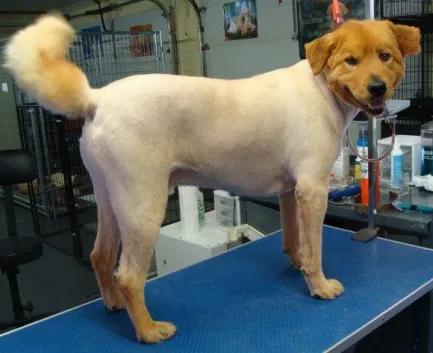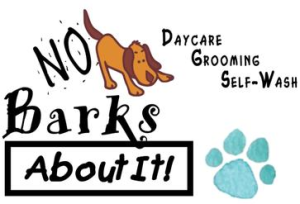
Summers in upstate NY can be hot! Dogs love to cool off with a swim or laying belly down on a nice, cool floor. Many owners want to help their furry friend stay cool, so they bring them to the groomers for a shave down – but does this really help your dog to stay cool?
 First, let’s talk a bit about the different coat types. There are double coated and single coated dogs. Single coats are dogs such as Poodles, Maltese and Shih-tzu. These breeds have hair that sheds in a similar fashion to human hair – it’s all one type of hair, and sheds in small amounts continuously. Many refer to these breeds as “non shedding” because they don’t lose noticeable clumps of hair. But this term is not really correct; in reality, the dog sheds, but you don’t notice it. These breeds can be safely shaved down and the coat will grow back with little trouble. You want to take care not to shave too short if the dog is outside often – too short leaves them susceptible to sunburn and bug bites.
First, let’s talk a bit about the different coat types. There are double coated and single coated dogs. Single coats are dogs such as Poodles, Maltese and Shih-tzu. These breeds have hair that sheds in a similar fashion to human hair – it’s all one type of hair, and sheds in small amounts continuously. Many refer to these breeds as “non shedding” because they don’t lose noticeable clumps of hair. But this term is not really correct; in reality, the dog sheds, but you don’t notice it. These breeds can be safely shaved down and the coat will grow back with little trouble. You want to take care not to shave too short if the dog is outside often – too short leaves them susceptible to sunburn and bug bites.
 Double coated dogs are breeds such as Labradors, German Shepherds, Huskies and Newfoundlands. Even the Pug is a double coated breed! These dogs have two distinct types of hair; a shiny outer layer of “guard hairs” and a fluffy, soft layer of “undercoat” underneath the guard hairs. Often the undercoat is lighter in color, or a different color entirely (like Golden Retrievers with white undercoat).
Double coated dogs are breeds such as Labradors, German Shepherds, Huskies and Newfoundlands. Even the Pug is a double coated breed! These dogs have two distinct types of hair; a shiny outer layer of “guard hairs” and a fluffy, soft layer of “undercoat” underneath the guard hairs. Often the undercoat is lighter in color, or a different color entirely (like Golden Retrievers with white undercoat).
You can think of these two types of hair like a forest. The guard hairs are the tall trees: they grow very slowly and live a very long time. The undercoat is like the weeds and brush on the forest floor: it grows quickly, densely, and dies off quickly as well. Many double coated breeds shed undercoat year round, with 2 noticeable “blow outs” in the spring and fall.
 Double coats are nature’s way of keeping your dog’s body temperature comfortable and stable. In the winter, the dense coat provides a layer of warmth and protection from the elements. Equally as important, during the summer that same coat provides an insulation against the heat and damaging rays of the sun. It also protects against bug bites, rashes and allergens. Think of it like your house – the insulation keeps it warm in the winter and cool in the summer. If your house had no insulation, you’d be hot and sweaty all summer long!
Double coats are nature’s way of keeping your dog’s body temperature comfortable and stable. In the winter, the dense coat provides a layer of warmth and protection from the elements. Equally as important, during the summer that same coat provides an insulation against the heat and damaging rays of the sun. It also protects against bug bites, rashes and allergens. Think of it like your house – the insulation keeps it warm in the winter and cool in the summer. If your house had no insulation, you’d be hot and sweaty all summer long!

 Shaving that double coat will make it almost impossible for your dog to cool itself, and your dog’s skin will be exposed to sunburn, bug bites and abrasions from sticks and other objects. Another common occurrence is called “Post Clipper Alopecia”. This is where the dog’s coat does not grow back properly – often leaving bald patches, uneven growth, or the coat becomes rough and frizzy as the guard hairs don’t grow back leaving only undercoat. Let’s go back to the forest analogy: if you remove all of the tall trees, the undergrowth will take over, choking out the growth of new trees. And even if the trees grow back, it will take a long time – just like your dog’s coat!
Shaving that double coat will make it almost impossible for your dog to cool itself, and your dog’s skin will be exposed to sunburn, bug bites and abrasions from sticks and other objects. Another common occurrence is called “Post Clipper Alopecia”. This is where the dog’s coat does not grow back properly – often leaving bald patches, uneven growth, or the coat becomes rough and frizzy as the guard hairs don’t grow back leaving only undercoat. Let’s go back to the forest analogy: if you remove all of the tall trees, the undergrowth will take over, choking out the growth of new trees. And even if the trees grow back, it will take a long time – just like your dog’s coat!
 So what can you do to keep your dog comfortable this summer? Brush, brush, brush! Removing the dead undercoat by regular, frequent brushing will allow air to circulate through the coat enabling your dog to stay cool and comfortable. If you allow the dead undercoat to remain packed, it blocks air flow and acts like a barrier – your dog’s skin can’t breathe, heat can’t dissipate and he’ll become overheated. If your dog has a super heavy coat, your groomer can shave a “summer belly” which is shaving the belly very short so he can have some direct skin contact on a cool surface when he lays down.
So what can you do to keep your dog comfortable this summer? Brush, brush, brush! Removing the dead undercoat by regular, frequent brushing will allow air to circulate through the coat enabling your dog to stay cool and comfortable. If you allow the dead undercoat to remain packed, it blocks air flow and acts like a barrier – your dog’s skin can’t breathe, heat can’t dissipate and he’ll become overheated. If your dog has a super heavy coat, your groomer can shave a “summer belly” which is shaving the belly very short so he can have some direct skin contact on a cool surface when he lays down.
Summer in the Finger Lakes is the best, and with regular brushing, your dog will enjoy the summer months as much as you!

 Everyone remembers being told about having too much of a good thing. This winter wasn’t our typical Upstate New York season! While the mild weather was a welcome reprieve, it means that the sub-zero temperatures that usually control the flea and tick population never quite got here. While keeping this creepy crawlies at bay should always be important, this year proves to be a real handful! Here’s a quick crash course on what these buggies are and why you should take them seriously!
Everyone remembers being told about having too much of a good thing. This winter wasn’t our typical Upstate New York season! While the mild weather was a welcome reprieve, it means that the sub-zero temperatures that usually control the flea and tick population never quite got here. While keeping this creepy crawlies at bay should always be important, this year proves to be a real handful! Here’s a quick crash course on what these buggies are and why you should take them seriously!
 It’s not just the fact that these critters are thankless parasites, though. It’s what comes along with the package. It’s not uncommon for animals to develop an allergy to flea bites known as pruritis, which shows itself as severe redness, itching, and scabs. Fleas also can transmit tapeworm, yet another parasite! Ticks are even worse. They can carry a whole host of diseases: Ehrlichia, Rocky Mountain Spotted Fever, anaplasmosis, tularemia, babesia, and last but most certainly not least, Lyme disease. Spread by the deer tick, a prevalent species in the area, Lyme disease can present itself in dogs with a fever, lameness, and overall lethargy. Humans can catch it just as easily as dogs, and our symptoms are generally flu-like.
It’s not just the fact that these critters are thankless parasites, though. It’s what comes along with the package. It’s not uncommon for animals to develop an allergy to flea bites known as pruritis, which shows itself as severe redness, itching, and scabs. Fleas also can transmit tapeworm, yet another parasite! Ticks are even worse. They can carry a whole host of diseases: Ehrlichia, Rocky Mountain Spotted Fever, anaplasmosis, tularemia, babesia, and last but most certainly not least, Lyme disease. Spread by the deer tick, a prevalent species in the area, Lyme disease can present itself in dogs with a fever, lameness, and overall lethargy. Humans can catch it just as easily as dogs, and our symptoms are generally flu-like. So what to do? Ticks and fleas are everywhere and are generally impossible to avoid, especially if you take your dogs for walks or hikes. The first step, as in any scenario, is prevention. Traditional drops like
So what to do? Ticks and fleas are everywhere and are generally impossible to avoid, especially if you take your dogs for walks or hikes. The first step, as in any scenario, is prevention. Traditional drops like